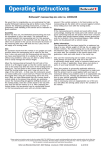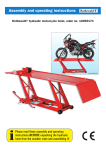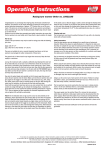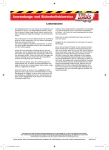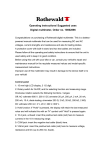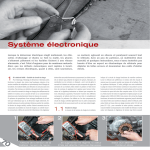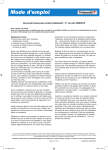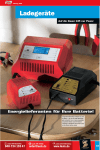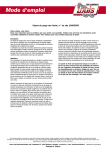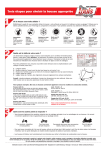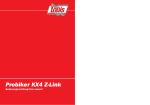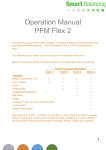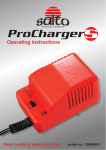Download Operating instructions
Transcript
Operating instructions 3-in-1 Digital Compression Tester, order no. 10034098 Comprises: • Digital compression tester in protective rubber casing, 20 bar max., with quick-release connection for fitting adapter hose to the spark plug thread, incl. 9V battery (battery compartment on back of tester). • 3 adapter hoses for 10, 12, 14mm spark plug threads 3 O-rings, 1 valve incl. valve core remover, as spares sure is saved electronically until the LÖSCHEN (CLEAR) button is pressed. Display: Continuous display of unit of measurement (1): Shows the selected unit of measurement (bar, psi or kPa). This momentary setting is retained when the device is switched on and off. Continuous pressure display (2): Shows the maximum pressure reached in the indicated cylinder until the pressure relief button (7) is pressed. Display of cylinder number (3): Shows the number of the cylinder for which the momentary and maximum pressures are displayed. The number changes when the ZYLINDER (CYLINDER) button is pressed. Maximum pressure display (4): Shows the maximum pressure in the indicated cylinder. This figure is saved until the LÖSCHEN (CLEAR) button (8) is pressed. Buttons AN/EINHEIT/AUS (ON/UNIT/OFF) button (5): Press this button to switch the compression tester on. Press it again to change the unit of measurement. Press the button for 3 seconds to switch the compression tester off. The compression tester switches itself off automatically if it is not used for six minutes. The compression measurements are retained when the tester is switched on and off. Cylinder Forwards button (6): Press this button to move on to the next cylinder number. The momentary and stored maximum pressure measurements for the last cylinder measured continue to be displayed until the pressure in the hose assembly is zeroed by pressing the pressure relief button or by disconnecting the hose at the quick release connection. Pressure relief button (7): Press this button to release the remaining pressure in the hose unit of the compression tester. The momentary pressure reading returns to zero, but the maximum pres- Functional overview The Rothewald Compression Tester can be used for wet and/or dry compression testing in order to determine the pressure created in the cylinders of a petrol engine. The unit can measure, display and save pressures of up to 300psi/20bar/2,000kPa for up to 12 cylinders. In the compression test, the momentary peak pressure is displayed in large numbers in the centre of the liquid crystal display. This reading is automatically saved and appears in small figures at the bottom right of the display. If the pressure relief button (7) is pressed, the momentary measurement on the display is zeroed, but the peak value is saved and still appears at the bottom right of the display. Repeat tests can be performed on the same cylinder and the new momentary peak value will be displayed in large numbers again. This new maximum value is only saved if it is higher than the maximum value from the previous test, or if the LÖSCHEN (CLEAR) button (8) is pressed in order to delete the old maximum value from the memory. Pressure measurements for up to 12 cylinders can be saved. Each reading is shown on the display together Please contact our technics centre via the fax number 0049(0) 40 - 734 195-58 resp. by email: [email protected] before using the article for the first time, if you have any questions on the product and/or these instructions. We will be happy to provide you with quick help. In this way, together we guarantee that the product is correctly assembled and used without any problems. Detlev Louis Motorradvertriebs GmbH - 21027 Hamburg, Germany - www.louis.eu - E-Mail: [email protected] GB_10034098.indd 1 As at 01/12 16.01.12 18:35 Operating instructions 3-in-1 Digital Compression Tester, order no. 10034098 with the corresponding cylinder number. The peak values can be compared by pressing the ZYLINDER (CYLINDER) button (6), either during testing or after all the cylinders have been tested. Individual readings can be deleted from the memory by pressing the LÖSCHEN (DELETE) button (8) while the relevant cylinder and its pressure measurements are displayed. If the LÖSCHEN (CLEAR) button (8) is pressed for 3 seconds at any time, the pressure measurements for all the cylinders will be deleted from the memory and the display returns to Cylinder 1. Carrying out a compression test An internal combustion engine in good operating condition creates a specific pressure in each cylinder. Normally the pressure should not vary by more than 10% between cylinders or from the engine manufacturer‘s guide figure. The larger the variance between cylinders or from the manufacturer‘s recommended pressure (the lower the compression), the greater the likelihood that this indicates serious engine wear, incorrect valve adjustment, a defective cylinder head gasket or a worn cylinder head. Engine wear can affect pistons and cylinders or valves and valve seats. If the combustion pressure is too high, this indicates major carbon build-up in the engine. The Rothewald compression tester enables you to carry out two tests: the “dry” and the “wet” compression test. The dry test procedure: 1. Refer to the owner‘s manual for the compression specifications of the engine. 2. Start the engine and wait until it reaches normal operating temperature – then switch off the engine. 3. Always put the vehicle into neutral before carrying out the test. 4. Make the cylinder head accessible so that the spark plugs can be screwed out. 5. Wear protective goggles. Use compressed air to carefully remove any dirt around the spark plugs. Wear gloves for protection against burns on the hot engine. 6. Pull off the spark plug connectors (do not pull on the ignition cable) and remove the spark plugs one by one. Mark each spark plug with the number of the cylinder and then place it on a clean, flat surface – this will help with finding any defective cylinders because the appearance of the plugs can be com pared with the compression reading for a particular cylinder. NOTE: If the engine has two plugs per cylinder, only one needs to be removed. 7. To prevent any risk of explosion caused by ignition sparks and to avoid damage to the electronic igniti on system, the primary (low voltage) circuit of the ignition system must always be disconnected throug- hout the test. For example, disconnect the power supply to the ignition coils. Dangerous high and low voltages occur in ignition systems. Always switch off the ignition or disconnect the battery before carrying out any work. 8. Remove the air filter and secure the throttle valves in the fully open position or open the carburettor valve fully (full throttle position). NOTE: Never place anything in the throttle body as this could cause internal engine damage. 9. Use the starter to turn the cam shaft over briefly with the plug threads open in order to eject any loose contaminants from the cylinders. 10. Select the correct adapter for the thread, depen- ding on the particular spark plug, and screw the adapter hand-tight into the plug hole of Cylinder 1 until the adapter‘s O-ring sits firmly. 11. Switch on the compression tester by pressing the AN/AUS (ON/OFF) button (5). 12. Press the ZYLINDER (CYLINDER) button (6) for at least three seconds to clear the memory and reset the cylinder display to “CYL 1”. 13. Observe the test display and, at the same time, crank the engine, using the starter button or kick starter, for approx. 10 compression strokes or just long enough that the pressure no longer rises (the peak pressure is automatically saved). Important: In vehicles with electronic fuel injection, the petrol-air mixture still reaches the cylinders when the ignition no longer has a power supply. If the engine is cranked for too long without igniti- on, petrol may accumulate on the pistons and will eventually get into the engine oil. To prevent this from happening, it is advisable to interrupt the power supply to the injection system if the engine has to turn for a prolonged periods without ignition (e.g. when testing numerous cylinders in succes sion). Vehicle service workshops use special auxiliary start switches in the starting circuit so that the starter can be operated while circumventing the ignition and electronic fuel injection. It is essen- tial to obtain precise information from your autho- rised dealer before working on a vehicle with electronic fuel injection to avoid problems, error messages from the vehicle electronics etc. 14. Press the pressure relief button (7) to depressurise the compression tester. 15. Disconnect the display unit and remove the adapter Please contact our technics centre via the fax number 0049(0) 40 - 734 195-58 resp. by email: [email protected] before using the article for the first time, if you have any questions on the product and/or these instructions. We will be happy to provide you with quick help. In this way, together we guarantee that the product is correctly assembled and used without any problems. Detlev Louis Motorradvertriebs GmbH - 21027 Hamburg, Germany - www.louis.eu - E-Mail: [email protected] GB_10034098.indd 2 As at 01/12 16.01.12 18:35 Operating instructions 3-in-1 Digital Compression Tester, order no. 10034098 16. 17. 18. 19. 20. 21. from Cylinder 1. Fit the adapter in Cylinder 2 and attach the com- pression tester. Press the ZYLINDER (CYLINDER) button (6) to change the cylinder number on the display from 1 to 2. Repeat the compression test on Cylinder 2 and all the remaining cylinders. Ensure that the cylinder number on the compression tester changes each time you move on to the next cylinder. When you have tested all the cylinders, look at the readings for each individual cylinder by pressing the ZYLINDER (CYLINDER) button (6). If individual measurements are too low or inconsistent, carry out the wet compression test (see below). On completion of the compression test, refit the spark plugs and connectors, and return all other components to their normal position. nozzles on many later vehicle models are activated by the ignition switch in starting mode. This could cause a fire hazard or contamination of the engine oil with fuel. It is essential to obtain precise information from your authorised dealer before working on a vehicle with electronic fuel injection to avoid problems, error messages from the vehicle electronics etc. Since this compression tester is a universal device and not intended just for one particular vehicle, it is important to make sure that it is suitable for your type of vehicle before you use it for the first time. Always follow the instructions in your vehicle owner’s manual and the directions of the vehicle manufacturer. This is essential as improper use of this product or its unsuitability for a vehicle could impair the safety and/or condition of the vehicle. The “wet” test procedure: The “wet” compression method ensures that the test is not influenced by the piston rings, pistons or cylinders. But it is only recommended for vehicles that are not fitted with a catalytic converter. On completion of the dry compression test, put approx. half a teaspoon of engine oil into each of the plug holes. Then repeat the compression test as described above. If the readings from the wet test are significantly higher, there is a pressure loss at the piston rings, which means worn pistons/ cylinders/piston rings, or damaged piston rings. If the readings from the dry and wet tests are approximately the same, but too low, the valves and/or valve seats may be damaged. Safety instructions: • Always wear protective goggles when carrying out a compression test. • The expected combustion pressure must not exceed the maximum rating of the compression tester, which is 20bar or 300psi or 2000kPa. • Always put the vehicle into neutral before carrying out the test. • Ensure that all connections are secure before carrying out the test. • Take precautions to prevent contact with hot engine parts. • Before cranking the engine, ensure that the ignition is disconnected from the electric circuit. For fuel-injected engines, it is advisable to disconnect the injection system from the vehicle‘s electrical system or to use an auxiliary starting switch (see above). The injection Please contact our technics centre via the fax number 0049(0) 40 - 734 195-58 resp. by email: [email protected] before using the article for the first time, if you have any questions on the product and/or these instructions. We will be happy to provide you with quick help. In this way, together we guarantee that the product is correctly assembled and used without any problems. Detlev Louis Motorradvertriebs GmbH - 21027 Hamburg, Germany - www.louis.eu - E-Mail: [email protected] GB_10034098.indd 3 As at 01/12 16.01.12 18:35



